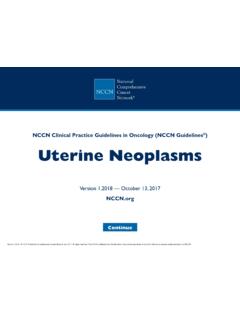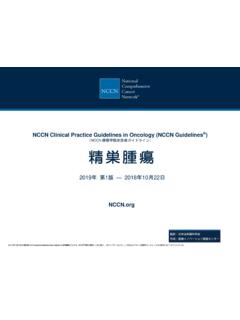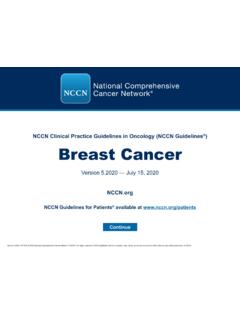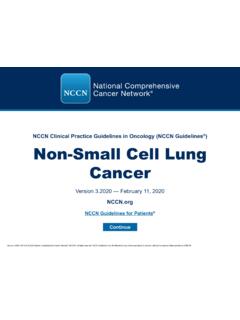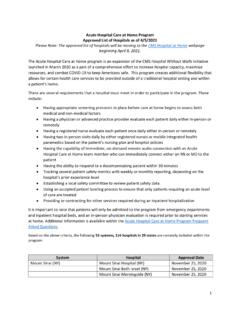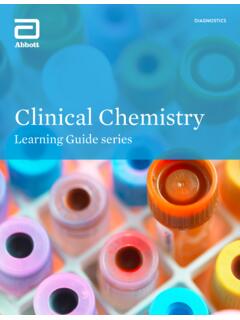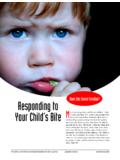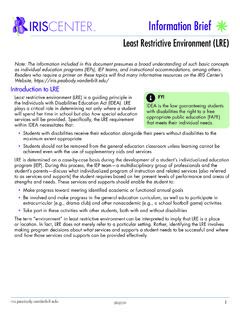Transcription of NCCN Clinical Practice Guidelines in Oncology (NCCN ...
1 , 05/17/19 2019 National Comprehensive Cancer Network ( nccn ), All rights reserved. nccn Guidelines and this illustration may not be reproduced in any form without the express written permission of Clinical Practice Guidelines in Oncology ( nccn Guidelines )Breast Cancer Screening and DiagnosisVersion May 17, 2019 Continue*Therese B. Bevers, MD/Chair The University of Texas MD Anderson Cancer center *Mark Helvie, MD/Vice-Chair ф University of Michigan Rogel Cancer CenterErmelinda Bonaccio, MD ф Roswell Park Comprehensive Cancer CenterKristine E. Calhoun, MD University of Washington/ Seattle Cancer Care AllianceMelissa Camp, MD The Sidney Kimmel Comprehensive Cancer center at Johns HopkinsMary B. Daly, MD, PhD Fox Chase Cancer CenterConstance Dobbins Lehman, MD, PhD ф Massachusetts General Hospital Cancer CenterWilliam B. Farrar, MD The Ohio State University Comprehensive Cancer center - James Cancer Hospital and Solove Research Institute Judy E.
2 Garber, MD, MPH Dana-Farber/Brigham and Women s Cancer center Richard Gray, MD Mayo Clinic Cancer center Randall E. Harris, MD, PhD The Ohio State University Comprehensive Cancer center - James Cancer Hospital and Solove Research Institute Teresa Helsten, MD UC San Diego Moores Cancer CenterLinda Hodgkiss, MD ф St. Jude Children s Research Hospital/ The University of Tennessee Health Science CenterTamarya L. Hoyt, MD ф vanderbilt -Ingram Cancer CenterJohn G. Huff, MD ф vanderbilt -Ingram Cancer CenterMaxine S. Jochelson, MD ф Memorial Sloan Kettering Cancer CenterBethany L. Niell, MD, PhD ф Moffitt Cancer CenterCatherine C. Parker, MD O'Neal Comprehensive Cancer center at UABMark Pearlman, MD University of Michigan Rogel Cancer CenterLiane Philpotts, MD ф Yale Cancer center /Smilow Cancer HospitalDonna Plecha, MD ф Case Comprehensive Cancer center /University Hospitals Seidman Cancer center and Cleveland Clinic Taussig Cancer InstituteJennifer K.
3 Plichta, MD, MS Duke Cancer InstituteMary Lou Smith, JD, MBA Research Advocacy NetworkRoberta M. Strigel, MD, MS ф University of Wisconsin Carbone Cancer CenterLusine Tumyan, MD ф City of Hope National medical CenterCheryl Williams, MD ф Fred & Pamela Buffett Cancer CenterNicole S. Winkler, MD ф Huntsman Cancer Institute at the University of UtahCatherine Young, MD ф Siteman Cancer center at Barnes- Jewish Hospital and Washington University School of MedicineContinueNCCN Guidelines Panel Disclosuresф Diagnostic/Interventional radiology Gynecologic Oncology /Gynecology Internist/Internal medicine, including family Practice , preventive management medical Oncology Pathology Patient advocacy Surgery/Surgical Oncology * Discussion Section Writing CommitteeNCCNMary Anne BergmanRashmi Kumar, PhDNCCN Guidelines Version Cancer Screening and DiagnosisVersion , 05/17/19 2019 National Comprehensive Cancer Network ( nccn ), All rights reserved.
4 nccn Guidelines and this illustration may not be reproduced in any form without the express written permission of Guidelines IndexTable of ContentsDiscussionNCCN Breast Cancer Screening and Diagnosis Panel MembersSummary of the Guidelines UpdatesClinical Encounter Including Risk Assessment (BSCR-1)Average Risk, Screening/Follow-Up (BSCR-1)Increased Risk, Screening/Follow-Up (BSCR-2)Symptomatic During Clinical Encounter, Presenting Signs/Symptoms (BSCR-4) Palpable Mass, Age 30 Years (BSCR-5) Palpable Mass, Age <30 Years (BSCR-11) Nipple Discharge, No Palpable Mass (BSCR-13) Asymmetric Thickening/Nodularity (BSCR-14) Skin Changes (BSCR-15)Persistent or Severe Breast Pain (BSCR-16)Recommendations for Follow-up of Axillary Mass (BSCR-18)Breast Cancer Presentation in Men (BSCR-19) Mammographic Evaluation (BSCR-20)Breast Screening Considerations (BSCR-A)Risk Factors Used in the Modified Gail Model, Age 35 Years (BSCR-B)Assessment Category Definitions (BSCR-C) Clinical Trials: nccn believes that the best management for any patient with cancer is in a Clinical trial.
5 Participation in Clinical trials is especially find Clinical trials online at nccn Member Institutions, click Categories of Evidence and Consensus: All recommendations are category 2A unless otherwise nccn Categories of Evidence and nccn Guidelines are a statement of evidence and consensus of the authors regarding their views of currently accepted approaches to treatment. Any clinician seeking to apply or consult the nccn Guidelines is expected to use independent medical judgment in the context of individual Clinical circumstances to determine any patient s care or treatment. The National Comprehensive Cancer Network ( nccn ) makes no representations or warranties of any kind regarding their content, use or application and disclaims any responsibility for their application or use in any way. The nccn Guidelines are copyrighted by National Comprehensive Cancer Network . All rights reserved.
6 The nccn Guidelines and the illustrations herein may not be reproduced in any form without the express written permission of nccn . Guidelines Version Cancer Screening and DiagnosisVersion , 05/17/19 2019 National Comprehensive Cancer Network ( nccn ), All rights reserved. nccn Guidelines and this illustration may not be reproduced in any form without the express written permission of Guidelines IndexTable of ContentsDiscussionUPDATES BSCR-1 Increased Risk: 2nd bullet modified: Women who have a lifetime risk 20% as defined by models that are largely dependent on family history 5th bullet modified: Women with a history of LCIS or ADH/ALH and greater than 20% lifetime risk 6th bullet, 1st sub-bullet modified: Referral to genetic counselor or similarly trained provider, if not already doneFootnotes: " b" modified: Medicare and insurers allow the patient direct access to scheduling for screening mammography.
7 "c" modified: At minimum medical and family history should be obtained and Clinical encounter should encompass ongoing risk assessment, risk reduction counseling, as well as a Clinical breast exam by a licensed provider. Refer to the nccn Guidelines for Breast Cancer Risk Reduction for a detailed qualitative and quantitative assessment. (Also for BSCR-2, BSCR-3) "i" modified: Randomized trials comparing Clinical breast exam versus no screening have not been performed. Rationale for recommending Clinical encounter is to maximize earliest detection of breast cancers and assure ongoing risk assessment. (Also for BSCR-2, BSCR-3) "l" modified: Tomosynthesis can decrease call back rates and appears to improve cancer detection but has not been sufficiently studied to determine if it improves disease-specific mortality. (Also for BSCR-2, BSCR-3)BSCR-2 Screening/Follow-up: 1st sub-bullet under Clinical encounter modified: to begin when identified as being at increased risk but not prior to age 21 y 2nd sub-bullet modified: Referral to genetic counseling or similarly trained provider, if not already done 1st sub-bullet under Annual screening modified: to begin 10 years prior to the youngest family member with breast cancer but not prior to age 30 yFootnotes: "m" modified: High-quality breast MRI limitations include having: a need for requires a dedicated breast coil, the ability to perform access to biopsy under MRI guidance, experienced radiologists in breast MRI, and regional availability.
8 Breast MRI is performed preferably days 7 15 of menstrual cycle for premenopausal women. MRI should be integrated correlated with other breast imaging modalities. "n" is new to the page, Consider whole breast ultrasound for those who qualify but cannot undergo MRI, corresponding to annual breast MRI. (Also for BSCR-3)BSCR-3 Increased Risk: Lower pathway modified: Women with a history of LCIS or ADH/ALH and greater than 20% lifetime risk 3rd bullet modified: Consider annual breast MRIBSCR-4 New pathway off, Symptomatic during Clinical encounter: Breast implant-related symptoms (effusion, enlargement, mass ulceration) >1 year post-implantation Consultation with multidisciplinary team with experience with implant related problems including BIA-ALCL For diagnostic workup of BIA-ALCL, see nccn Guidelines for T-Cell LymphomasFootnotes: "o" is new to the page: Individuals with breast implants have a risk of developing breast implant-associated anaplastic large cell lymphoma (BIA-ALCL) (Average 8 10 years after implantation).
9 Majority of cases have been seen in textured Evaluation: +Ultrasound was added to Diagnostic mammogram 3rd column, significantly : Revised: Follow-up After Core Needle Biopsy (See BSCR-8)Updates in Version of the nccn Guidelines for Breast Cancer Screening and Diagnosis from Version include:ContinuedNCCN Guidelines Version Cancer Screening and DiagnosisVersion , 05/17/19 2019 National Comprehensive Cancer Network ( nccn ), All rights reserved. nccn Guidelines and this illustration may not be reproduced in any form without the express written permission of Guidelines IndexTable of ContentsDiscussionUpdates in Version of the nccn Guidelines for Breast Cancer Screening and Diagnosis from Version include:BSCR-5 (continued)Footnotes: "p" modified: There are some Clinical circumstances such as mass with low Clinical suspicion or suspected simple cyst in which ultrasound would be preferred as the first imaging modality and may suffice for women 30 39 years of age.
10 See Top pathway off Solid Mass modified: Physical exam ultrasound and/or diagnostic mammogram every 6 mo for 1 2 y to assess for imaging changes (Also for lower pathway off Suspected complicated cyst). Bottom pathway off Suspected complicated cyst modified: Short-term follow-up Probably benign finding BI-RADS category 3 Following modified to include: Confirmed complicated cyst with visible mobility of internal components (BI-RADS category 2, benign)Footnotes: "x" is new to the page: May be considered to confirm cystic nature for symptoms or possible abscess corresponding to Aspiration arm off Suspected complicted cystBSCR-7 For age 30 y pathway modified: Observe Clinical Breast Exam for low Clinical suspicion mammogram/ultrasound for 1 2 y to assess for imaging changesBSCR-8 Top pathway modified: Physical exam ultrasound and/or mammogram at 6 or 12 mo for 1 y to assess for imaging changes (Also for BSCR-12).

